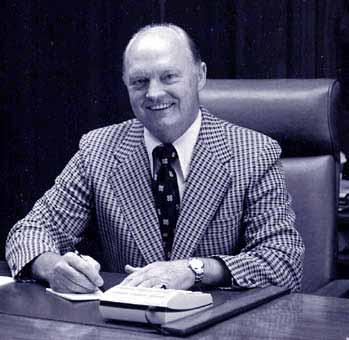I first met Roland E. (“Stormy”) Goss in the summer of 1973. At that time he was a successful Dallas businessman and was president of his own company. In his spare time, among many other activities, he was a college football official and traveled throughout the country on weekends officiating games. Most importantly from my point of view, however, was his daughter Janis whom I had met two years earlier and wished some day to marry. Fortunately, I only had to wait one year before that wish was fulfilled.
As I got to know Stormy, it did not take me long to realize that the seminal experience of what was a remarkably full life involved his service during World War II. He had joined the Navy immediately after the Pearl Harbor attack and was involved in the D-Day invasion at Normandy. From time to time he would tell us about the horrific carnage he witnessed during the D-Day landings and the memories would often overwhelm him to such an extent that he struggled to hold back the tears. To see this extraordinarily strong man overcome in this manner helped us to understand just how searing his war experiences must have been.

Roland Goss, President, Airsco
It wasn’t until the film “Saving Private Ryan” was released in 1998 that I fully comprehended the trauma that D-Day must have caused for all those involved. All of the members of Stormy’s family who saw the film agreed that he should not see it because the memories it would evoke would be too painful. However, Janis’s two brothers and I made sure that our children saw the film so that they would fully appreciate what their grandfather and others like him had sacrificed during the war.
However, D-Day was not the only major operation of Stormy’s wartime career. He was also heavily engaged in a unique but historically obscure naval operation involving the attempt by the Allied army to cross the Rhine River in their final push into the heart of Germany. He and another naval officer were assigned to the army and given the task of commanding the crews of the landing craft that were to be used to ferry the American forces across the Rhine. The significance of the crossing was magnified for him by the fact that during this operation his closest wartime friend was killed in the foxhole right next to him by an exploding cannon shell. After the war, Stormy paid tribute to his fallen comrade by naming his oldest son after him.
As with many servicemen during this war, and probably in most wars, Stormy Goss was a prolific correspondent. When not involved in military operations, servicemen usually have an abundance of spare time. They spend much of this time writing letters not only as a connection with home but as a way of ensuring that they receive letters in return. “Mail-Call” was usually the high point of each day. Goss wrote hundreds of letters—mostly to his parents, Mr. and Mrs. Dean Goss and to his girlfriend, and future wife, Kay Goodman. He also saved newspaper and magazine articles and photographs related to his wartime experiences and gave a number of interviews throughout the post-war years. (Transcribed versions of the complete letters are in the Appendix and individual letters can also be accessed by clicking the appropriate dates in the footnotes.)
These materials comprise a rich and untapped archive that provides historical insight into the thoughts and emotions of one World War II combat veteran and are the underpinning and reason for this website. It is hoped that this is the beginning of what will someday be a comprehensive site dedicated to providing one more first-hand account of some of the major events of the most cataclysmic conflict of the twentieth century. Since most World War II veterans are now in their eighties, the potential of oral histories as a source for first-hand descriptions diminishes exponentially every year. This increases the historical value of the kind of written accounts represented by the materials in this site.
